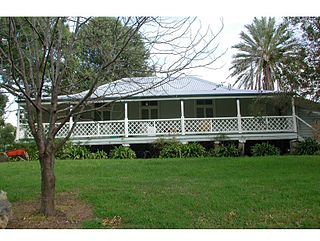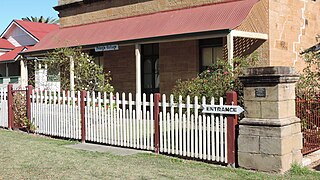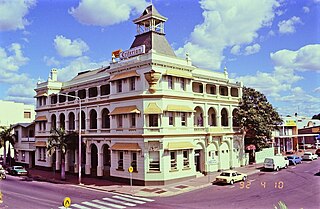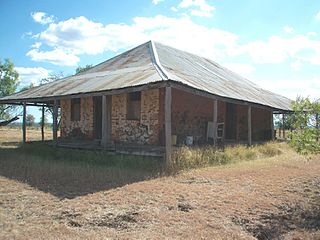
Glenmore Homestead is a heritage-listed homestead at Belmont Road, Parkhurst, Rockhampton Region, Queensland, Australia. It was built from c. 1858 to c. 1920. The homestead and associated buildings once belonged to pastoral run on the Fitzroy River, seven kilometres northwest of Rockhampton, Queensland. Originally much larger at 127 square miles the current size of the property is 20 acres (8.1 ha). It was added to the Queensland Heritage Register on 21 October 1992.

Canning Downs was the first residential establishment built by a white person on the Darling Downs in Queensland, Australia. It is located a short drive from the town of Warwick and originally extended south east to Killarney and the McPherson Range. The area was first named after the British statesman George Canning by Allan Cunningham.

Jondaryan Homestead is a heritage-listed homestead at Evanslea Road, Jondaryan, Toowoomba Region, Queensland, Australia. It was the base of the former Jondaryan pastoral station, which was originally taken up in 1840, and at one time was the largest freehold station in Queensland. The site contains the current house, which was built after the original was destroyed by fire in 1937, the original kitchen dating from 1844, and a kitchen, butcher's shop, shearer's quarters, stables, dairy, toilet block and store, many dating from the 1860s. It also contains the remains of horse stalls, a slaughterhouse, hide store, and Chinese gardener's glasshouse. It was added to the Queensland Heritage Register on 21 October 1992.

Pringle Cottage is a heritage-listed cottage at 81 Dragon Street, Warwick, Southern Downs Region, Queensland, Australia. It was built from 1860s/1870s onwards by John McColluch. It is also known as John McCulloch's Cottage, Mountview, Milton College, and Miss Lukin's Boarding School. It was added to the Queensland Heritage Register on 21 October 1992.

Rockhampton Courthouse is a heritage-listed courthouse at 42 East Street, Rockhampton, Rockhampton Region, Queensland, Australia. It was designed by John Hitch and built from 1950 to 1955. It is also known as District Court, Queensland Government Savings Bank, Commonwealth Bank, Magistrate's Court, Police Court, and Supreme Court. It was added to the Queensland Heritage Register on 21 October 1992.

Gracemere Homestead is a heritage-listed homestead at 234 Gracemere Road, Gracemere, Rockhampton Region, Queensland, Australia. It was built from 1858 to 1890s. It was added to the Queensland Heritage Register on 21 October 1992.

Grand Hotel is a heritage-listed hotel at 39 Central Street, Mount Morgan, Rockhampton Region, Queensland, Australia. It was built c. 1901. It was added to the Queensland Heritage Register on 21 October 1992.

Avonleigh is a heritage-listed house at 248 Quay Street, Rockhampton, Rockhampton Region, Queensland, Australia. It was built in 1885 by Robert Cousins & Walter Lawson. It was added to the Queensland Heritage Register on 21 October 1992.

The Range Convent and High School is a heritage-listed private school at 263 Agnes Street, The Range, Rockhampton, Rockhampton Region, Queensland, Australia. It was built from c.1880s to 1930s. It is also known as Our Lady of Good Counsel Convent and School and The Catholic College Residential. It was added to the Queensland Heritage Register on 21 October 1992.

Criterion Hotel is a heritage-listed hotel at 150 Quay Street, Rockhampton, Rockhampton Region, Queensland, Australia. It was designed by James Flint and built from 1889 to 1890. It was added to the Queensland Heritage Register on 21 October 1992.

Rockhampton Club is a heritage-listed former club house at 166 Quay Street, Rockhampton, Rockhampton Region, Queensland, Australia. It was designed by James Flint and built from c. 1892 to 1893. It was added to the Queensland Heritage Register on 21 October 1992.

Trustee Chambers is a heritage-listed former house and subsequent commercial building at 170 Quay Street, Rockhampton, Rockhampton Region, Queensland, Australia. It was designed by architect John William Wilson and built from 1876 to 1877. It is also known as Residence of Dr William Callaghan and River Chambers. It was added to the Queensland Heritage Register on 21 October 1992.

Yungaba is a heritage-listed villa at 74 Ward Street, The Range, Rockhampton, Rockhampton Region, Queensland, Australia. The design is attributed to James Flint and it was built from 1890 to 1950s. It was added to the Queensland Heritage Register on 24 March 2000. Although originally constructed as a private residence, it was known as "Yungaba Migrant Hostel" during its use as a migrant hostel in the 1950s.

Killowen is a heritage-listed detached house at 86 Ward Street, The Range, Rockhampton, Rockhampton Region, Queensland, Australia. It was designed by Eaton & Bates and built from c. 1898 to c. 1920. It is also known as Boland Residence. It was added to the Queensland Heritage Register on 21 October 1992.

Clancholla is a heritage-listed villa at 25 Ward Street, The Range, Rockhampton, Rockhampton Region, Queensland, Australia. It was built c. 1922. It was added to the Queensland Heritage Register on 12 January 2003.

Rockhampton Botanic Gardens is a heritage-listed botanic garden at 100 Spencer Street, The Range, Rockhampton, Rockhampton Region, Queensland, Australia. It was built from 1873 to 1930s. It was added to the Queensland Heritage Register on 23 July 1999.

St Aubins is a heritage-listed detached house at 75 Canoona Road, West Rockhampton, Rockhampton, Rockhampton Region, Queensland, Australia. It was built c. 1889. It was added to the Queensland Heritage Register on 21 October 1992.

Stone Farm Building is a heritage-listed farm building at Fleurs, 739 Fleurs Lane, Clermont, Isaac Region, Queensland, Australia. It was built in 1880s. It is also known as Fleurs. It was added to the Queensland Heritage Register on 28 August 2008.

Tarong Homestead is a heritage-listed homestead at Cooyar Road, Tarong, South Burnett Region, Queensland, Australia. It was built from 1840s circa to 1890s circa. It was added to the Queensland Heritage Register on 21 October 1992.

























